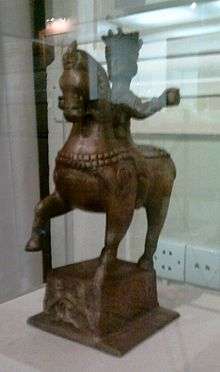Javanshir
| Javanshir | |
|---|---|
| King of Caucasian Albania | |
 Copy of the bronze sculpture of Javanshir in the National Museum of History of Azerbaijan (original is in Hermitage) | |
| Reign | 637 — 680 |
| Coronation | 637 |
| Predecessor | Varaz Grigor |
| Successor | Varaz Trdat |
| Born | September 28, 616 |
| Died | January 1, 680 (aged 63) |
| Burial | Gardman castle |
| Issue | Varaz Trdat |
| Dynasty | Mihranids |
| Father | Varaz Grigor |
| Mother | Goridouxt |
| Religion | Christianity |
Javanshir (Armenian: Ջիվանշիր, Jivanshir; Middle Persian: Jūvānšīr; meaning "young lion"), was the prince of Caucasian Albania from 637 to 680, hailing from the region of Gardman. His life and deeds were the subject of legends that were recorded in Armenian medieval texts. He was from the Parthian Mihranid family, an offshoot of the House of Mihran, one of the seven Parthian clans of the Sasanian Empire.[1][2]
Early life
Javanshir was the second son of Varaz Grigor, a prince of Gardman who belonged to the Mihranid family, and an Iberian princess named Goridouxt. In 637 Varaz Grigor was baptised and declared Christianity as the official religion of Caucasian Albania, thus making his son, Javanshir, convert too. However, Varaz was deposed by the Sasanian king who didn't acknowledge his conversion to Christianity. Thus Javanshir became the king of Caucasian Albania.[3]
Reign
Javanshir was known for his bravery and intelligence; he fought against the Arabs during the Muslim conquest of Persia on the side of the Sasanian Empire, and was rewarded by the Sasanian king Yazdegerd III himself two golden spears, two golden shields and a flag,[4] probably the Derafsh Kaviani. In 636, he led an Albanian army, which alongside the Armenian prince Musel III Mamikonian and Grigor of Syunik, took part in the Battle of al-Qādisiyyah between the Persian and Arab armies. However, the Sasanians were defeated, which made Javanshir lose hope. He then made a mutiny against his overlords and retreated to Caucasian Albania. Where he wrote a letter to Constans II and became ally with the Byzantine Empire. He was then awarded with the title of patrikios, and recognized as king of the East. He also married to a noble from a princely family of Syunik.
After his alliance with the Byzantines, he joined his forces with the Iberian king Adarnase I in an attack on Sasanian garrisons in Albania.[5] He later expanded his dominion from Derbent to Aras river.
Facing the threat of the Arab invasion on the south and the Khazar offensive on the north, Javanshir had to recognize the Caliph’s suzerainty, a move, which would prove to be a turning point in the country's history.
Javanshir was assassinated, in 680, by the rival nobles, whose power he had tried to restrict. He was succeeded by Varaz Trdat.
Depiction in Armenian Poetry and Historical Texts
The only historical source about the life and deeds of Javanshir comes from the Armenian text by Movses Kaghankatvatsi, known as History of the Land of Aghvank.[6] Movses Kaghankatvatsi's text includes a poem dedicated to Javanshir Elegy on the Death of the Great Prince Jevansher by Davtak Kertogh (Davtak the Poet), a 7th-century Armenian poet and the first secular writer in Armenian literature.[7][8]
The only surviving poem by Kertogh is written in Armenian, in alphabetical acrostic verse.
See also
References
- ↑ "ARRĀN – Encyclopaedia Iranica. C. E. Bosworth". iranicaonline.org. Retrieved 2014-12-11.
- ↑ "ALBANIA – Encyclopaedia Iranica. M. L. Chaumont". iranicaonline.org. Retrieved 2014-12-11.
- ↑ Cyril Toumanoff. Review of C. J. F. Dowsett's "The History of Caucasian Albanians by Movsēs Dasxuranci", Bulletin of the School of Oriental and African Studies, University of London, Vol. 25, No. 1/3. (1962), p. 366
- ↑ http://books.google.dk/books?id=EkKXsC_Lhw4C&pg=PA36&dq=Javanshir+albania&hl=da&sa=X&ei=AvWdUprOCaGe4wSC3YFI&ved=0CEEQ6AEwADgK#v=onepage&q=Javanshir%20albania&f=false
- ↑ Martindale, John Robert (1992), The Prosopography of the Later Roman Empire, pp. 13-14. Cambridge University Press, ISBN 0-521-07233-6.
- ↑ Robert H. Hewsen, “Ethno-History and the Armenian Influence upon the Caucasian Albanians,” in Classical Armenian Culture: Influences and Creativity, ed. Thomas J. Samuelian (Philadelphia: Scholars Press, 1982)
- ↑ The Oxford History of Historical Writing: 400-1400 / Edited by Sarah Foot, Chase F. Robinson. — Oxford University Press, 2012. — Vol. 2. — p. 189.:"The section on Juansers exploits concludes with the earliest piece of secular Armenian poetry since the adoption of Christianity to have reached us, in the form of an abecedarian elegy extolling the prince and bewailing his passing."
- ↑ The Heritage of Armenian Literature: By Agop Jack Hacikyan, Gabriel Basmajian, Edward S. Franchuk, Nourhan Ouzounian, Wayne State University Press, 2002, P. 94
Sources
- Chaumont, M. L. (1985). "ALBANIA". Encyclopaedia Iranica, Vol. I, Fasc. 8. pp. 806–810.
- Bosworth, C. Edmund (1986). "ARRĀN". Encyclopaedia Iranica, Vol. II, Fasc. 5. C. Edmund Bosworth. pp. 520–522.